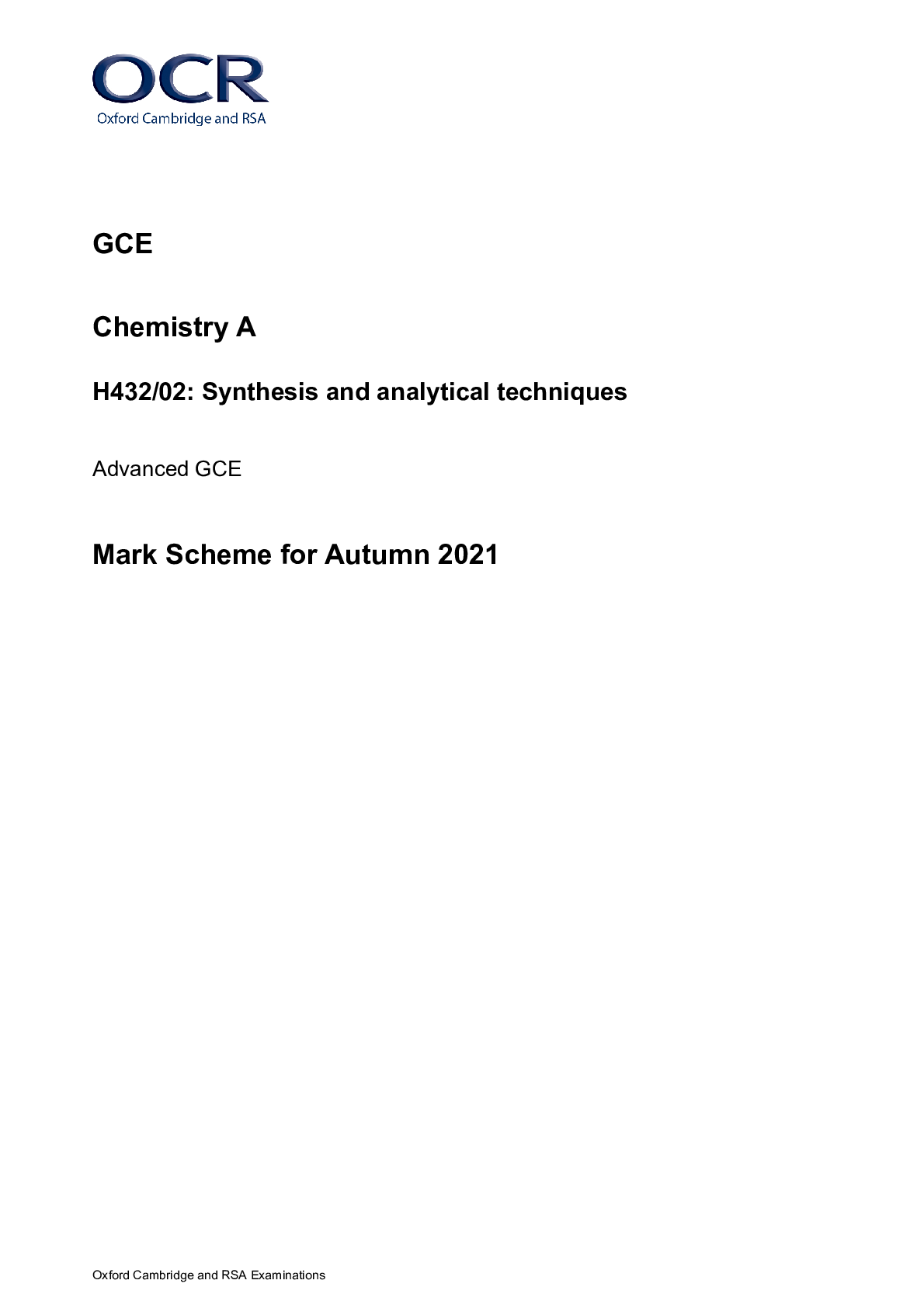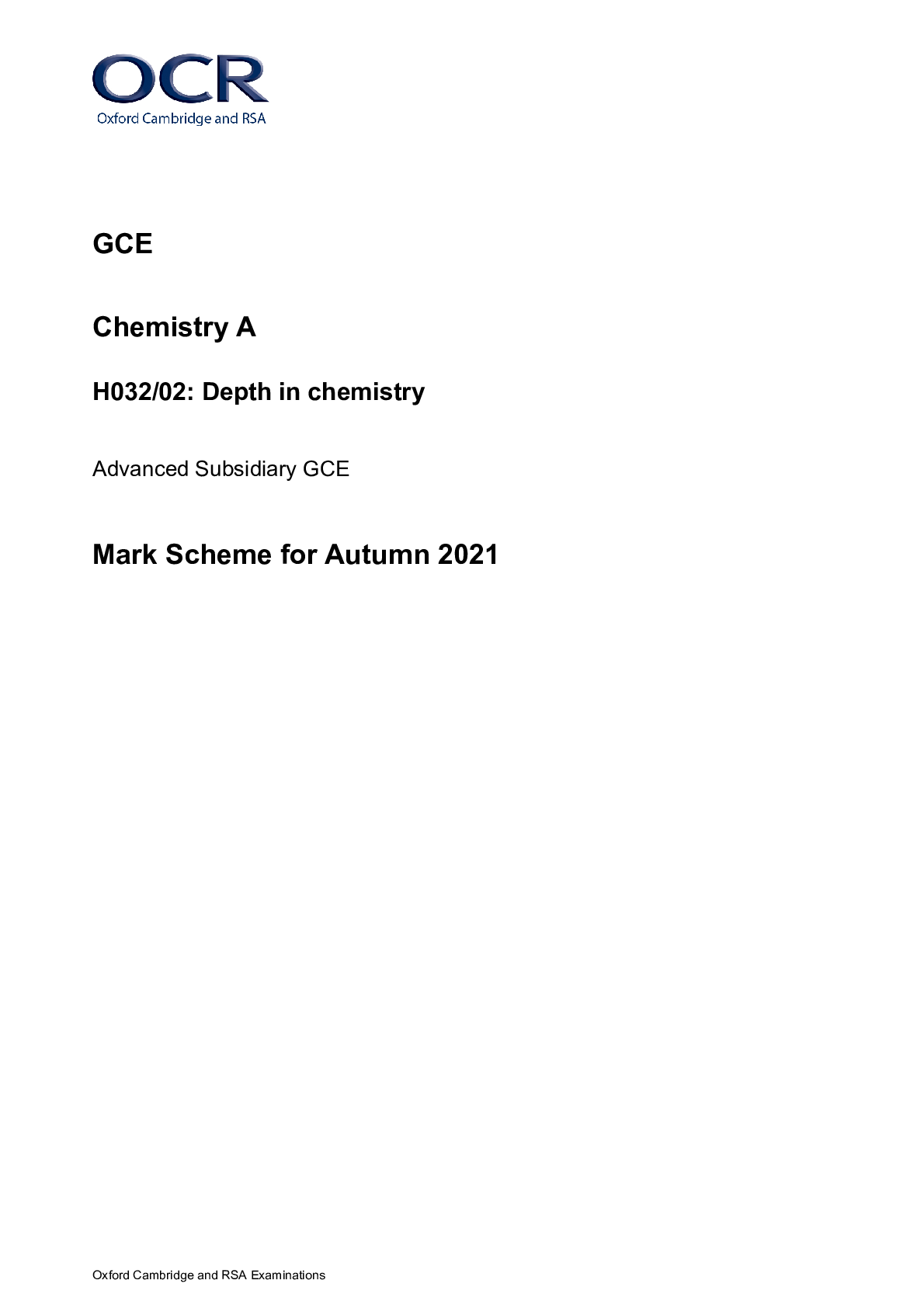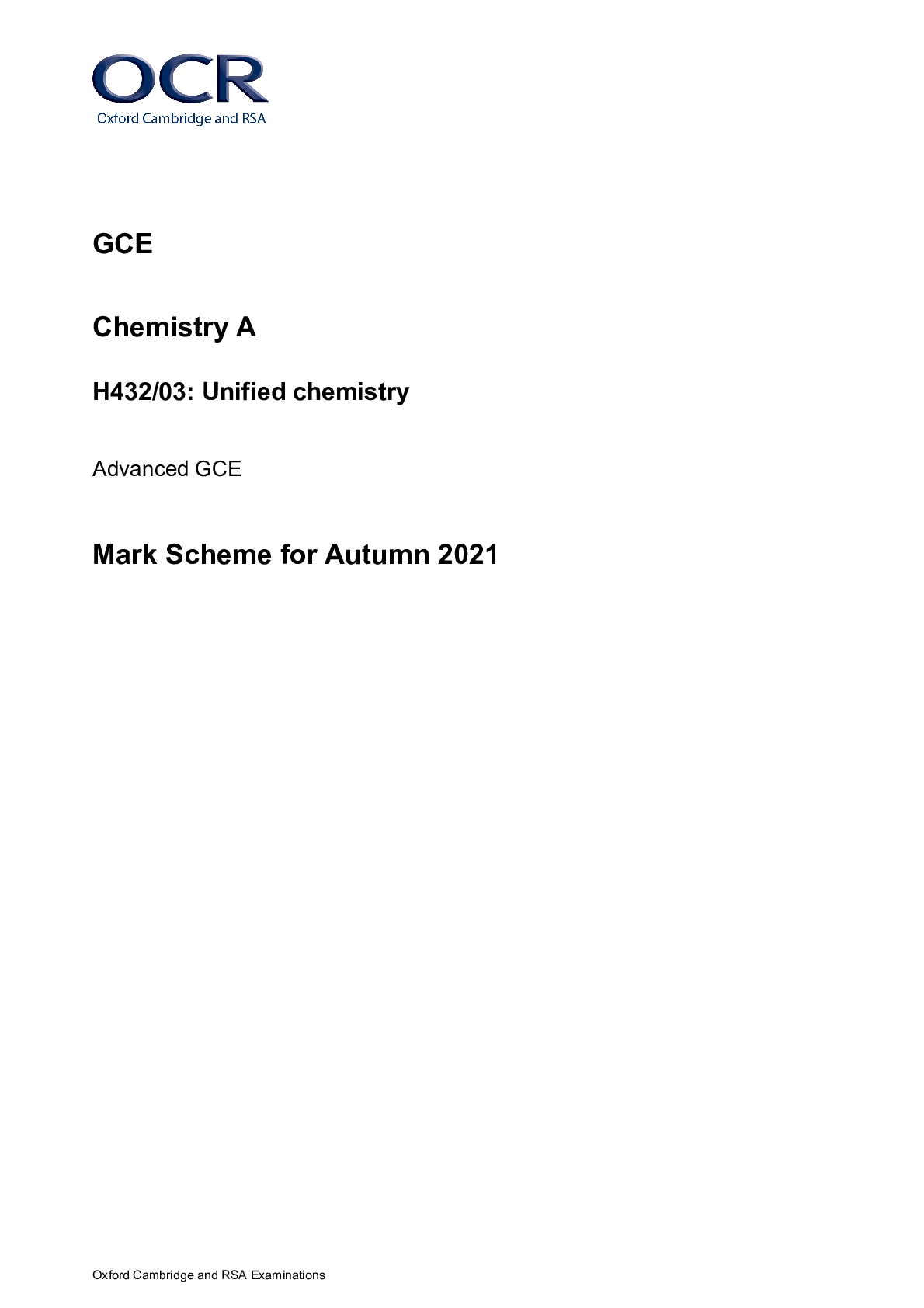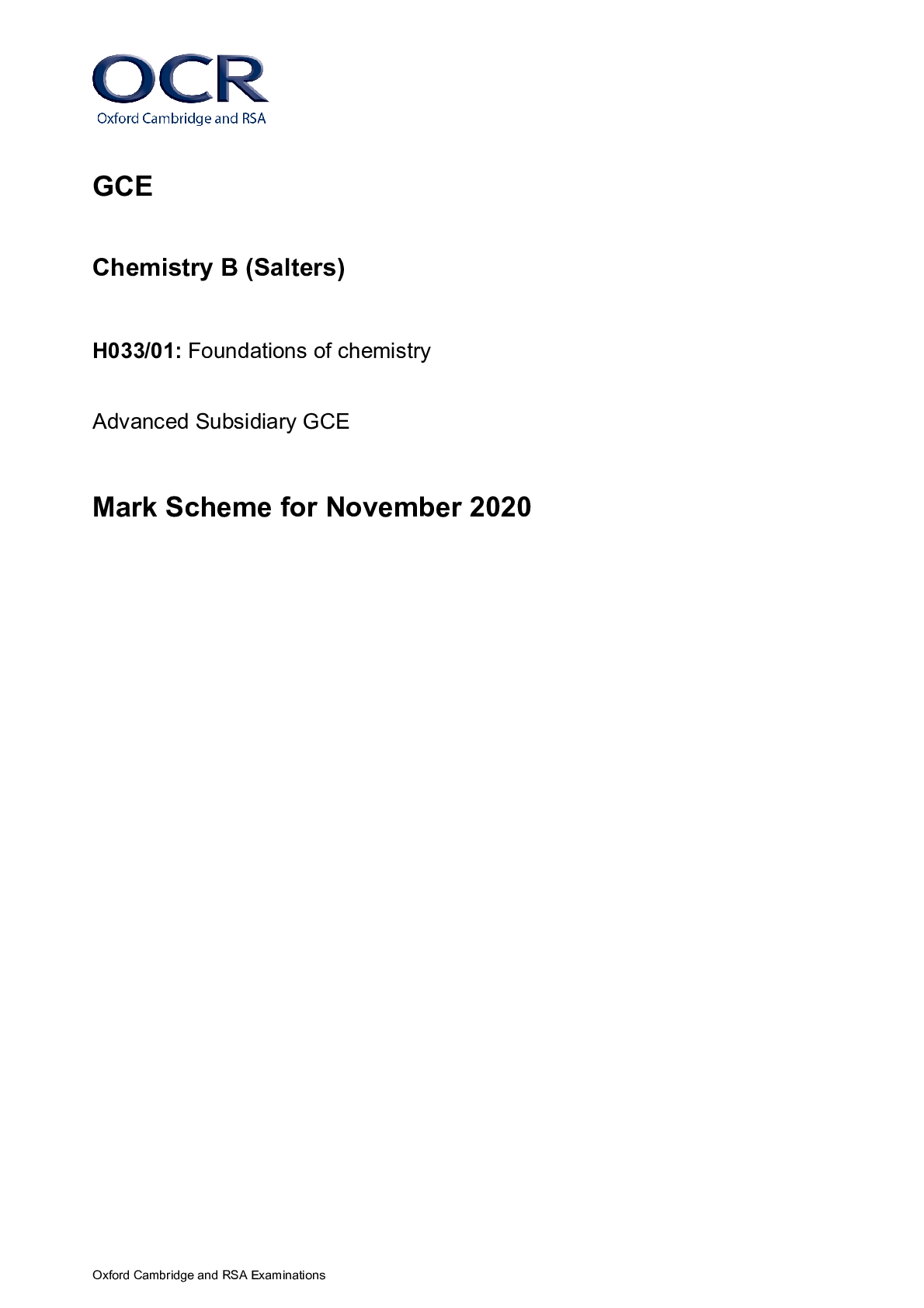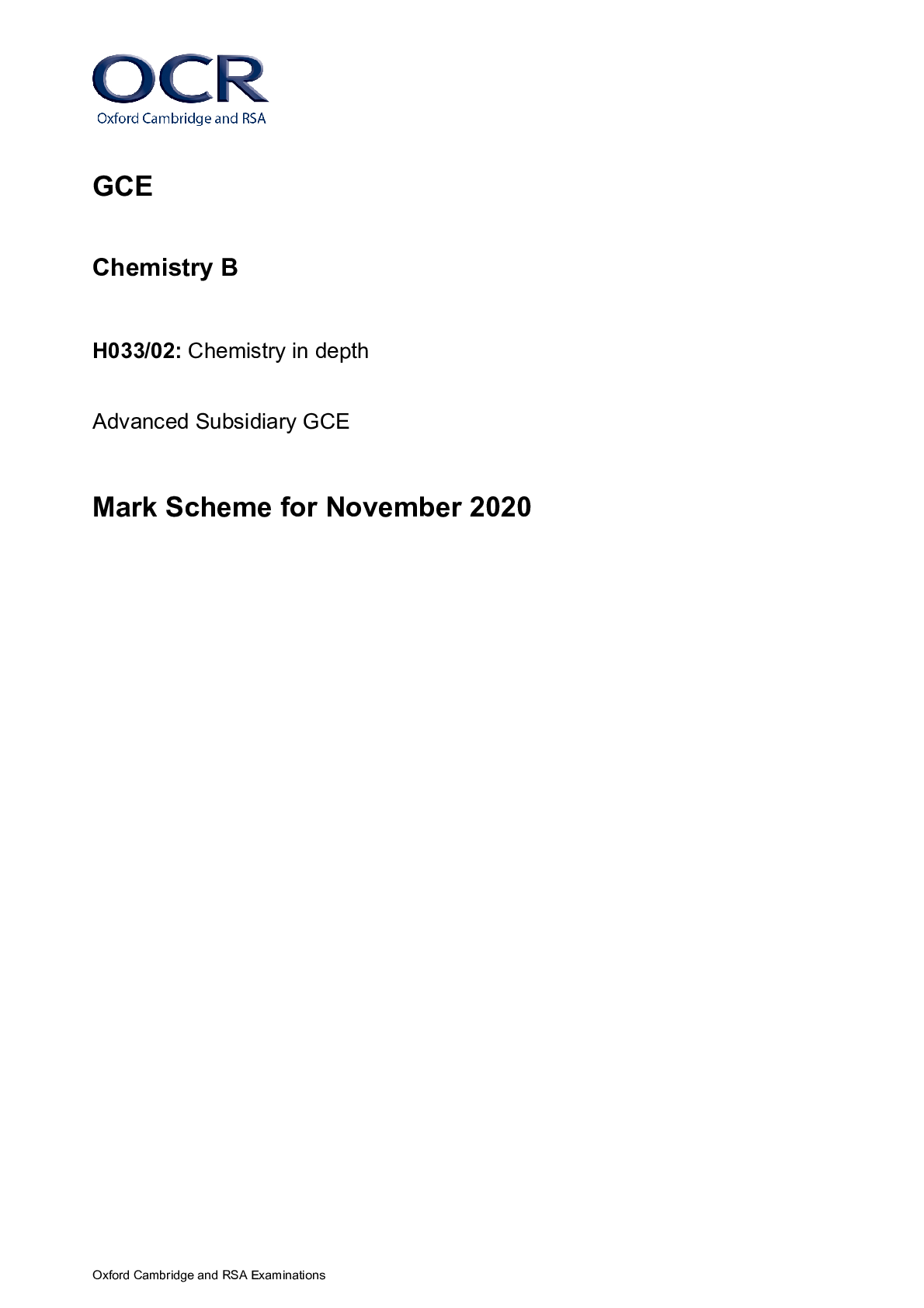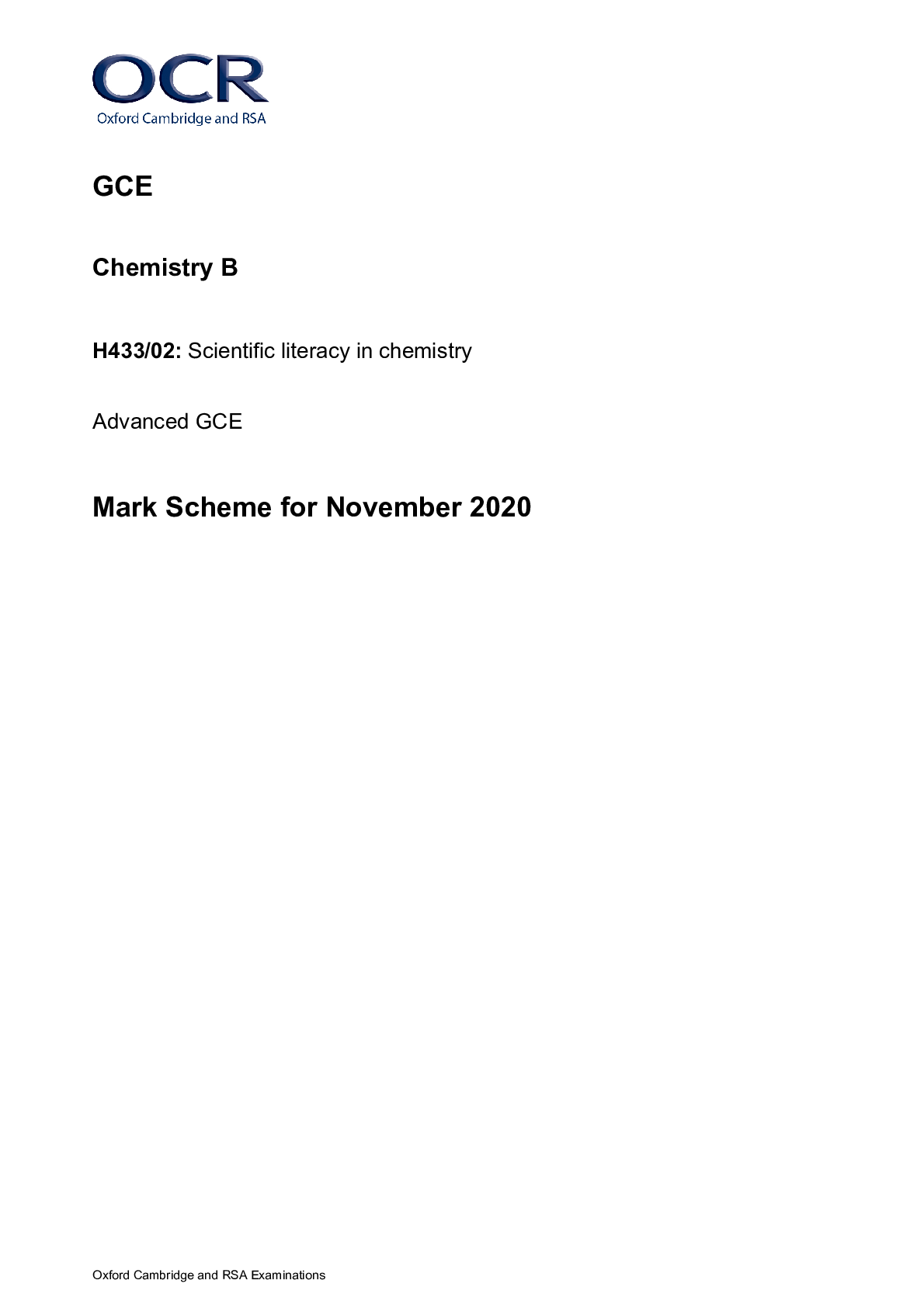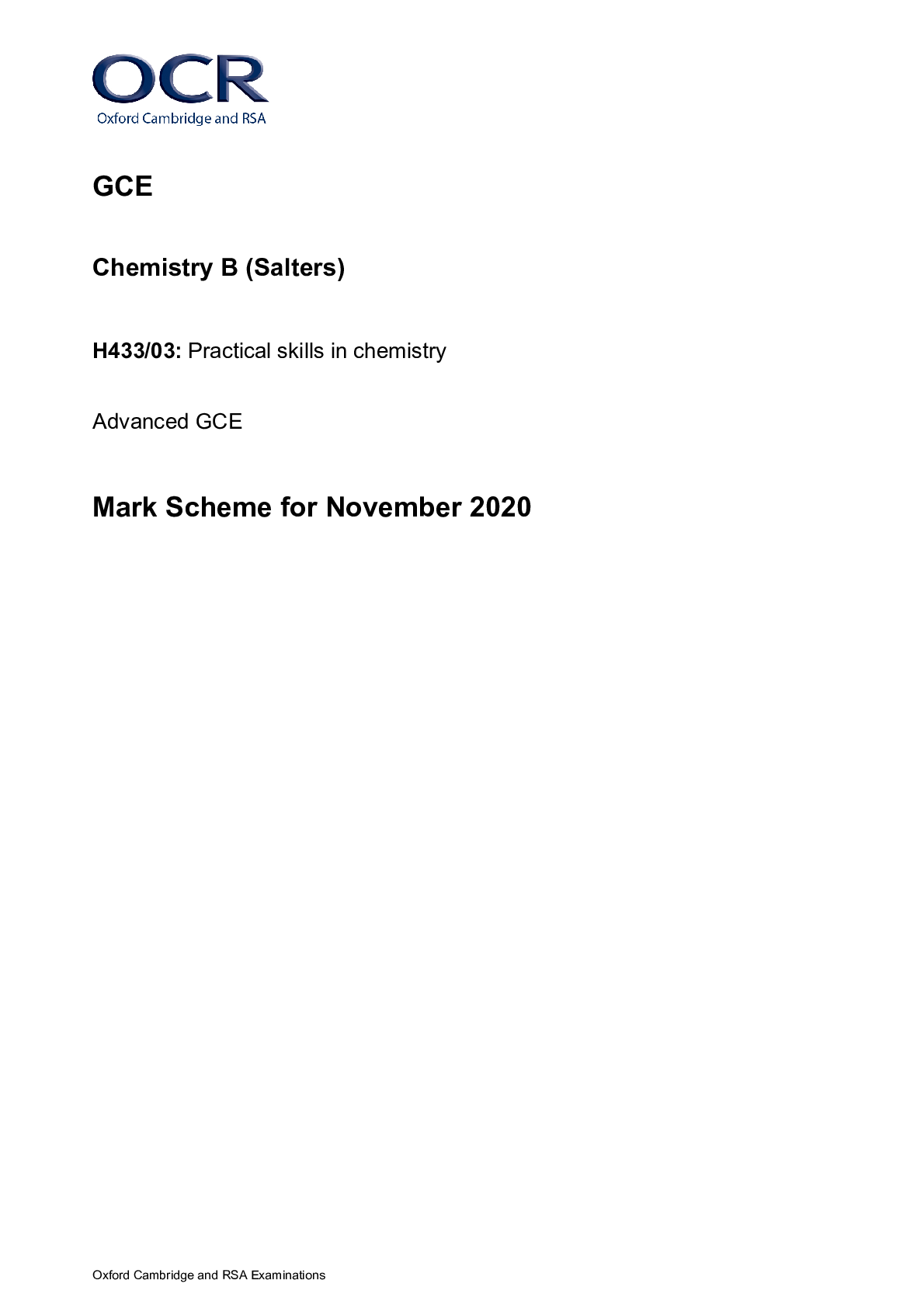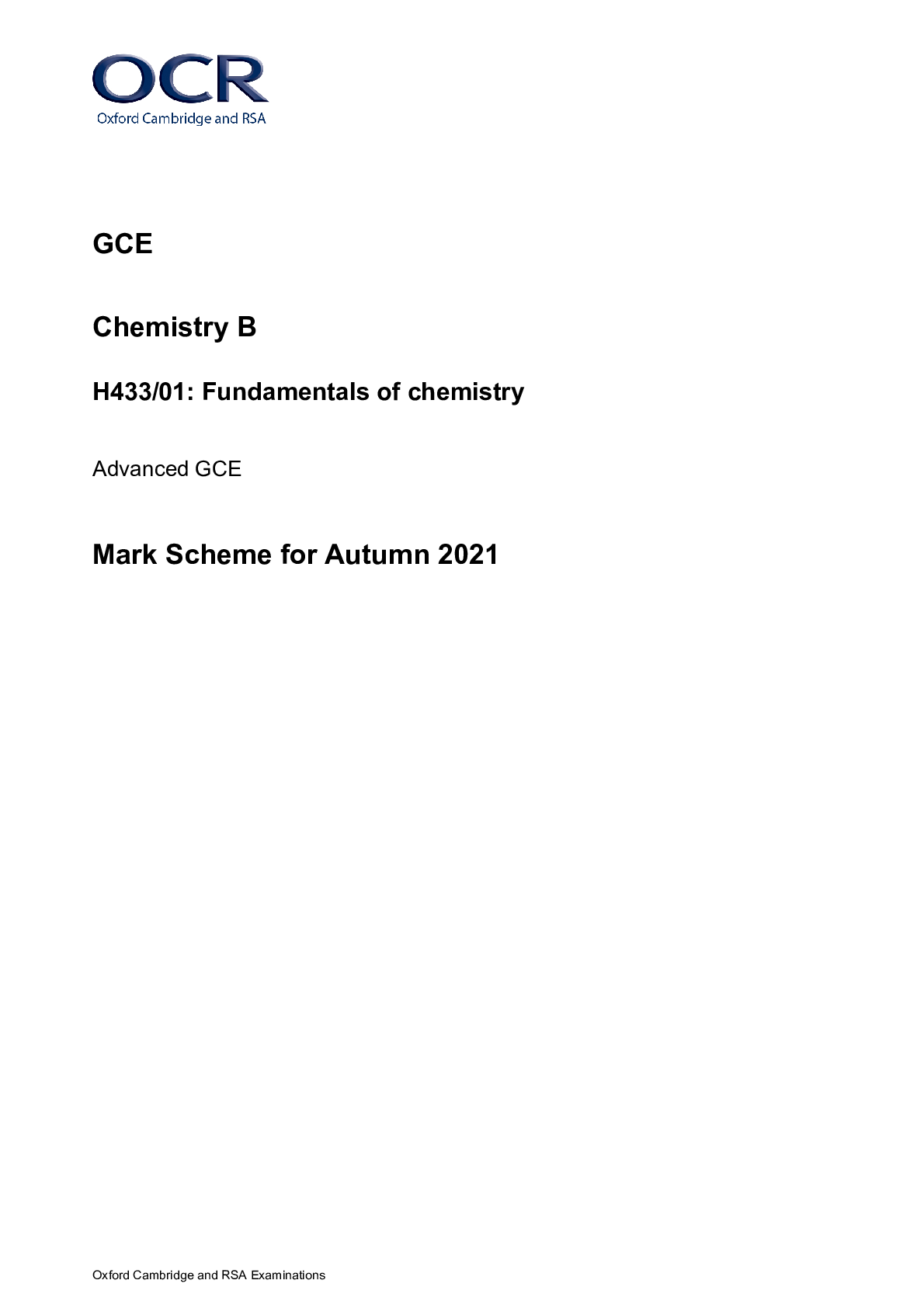Chemistry > GCSE MARK SCHEME > GCE Chemistry A H032/01: Breadth in chemistry Advanced Subsidiary GCE Mark Scheme for Autumn 2021 (All)
GCE Chemistry A H032/01: Breadth in chemistry Advanced Subsidiary GCE Mark Scheme for Autumn 2021
Document Content and Description Below
GCE Chemistry A H032/01: Breadth in chemistry Advanced Subsidiary GCE Mark Scheme for Autumn 2021 Oxford Cambridge and RSA Examinations GCE Chemistry A H032/01: Breadth in chemistry Advanced Subs... idiary GCE Mark Scheme for Autumn 2021Oxford Cambridge and RSA Examinations OCR (Oxford Cambridge and RSA) is a leading UK awarding body, providing a wide range of qualifications to meet the needs of candidates of all ages and abilities. OCR qualifications include AS/A Levels, Diplomas, GCSEs, Cambridge Nationals, Cambridge Technicals, Functional Skills, Key Skills, Entry Level qualifications, NVQs and vocational qualifications in areas such as IT, business, languages, teaching/training, administration and secretarial skills. It is also responsible for developing new specifications to meet national requirements and the needs of students and teachers. OCR is a not-for-profit organisation; any surplus made is invested back into the establishment to help towards the development of qualifications and support, which keep pace with the changing needs of today’s society. This mark scheme is published as an aid to teachers and students, to indicate the requirements of the examination. It shows the basis on which marks were awarded by examiners. It does not indicate the details of the discussions which took place at an examiners’ meeting before marking commenced. All examiners are instructed that alternative correct answers and unexpected approaches in candidates’ scripts must be given marks that fairly reflect the relevant knowledge and skills demonstrated. Mark schemes should be read in conjunction with the published question papers and the report on the examination. © OCR 20211. Annotations Annotation Meaning Correct response Incorrect response Omission mark Benefit of doubt given Contradiction Rounding error Error in number of significant figures Error carried forward Level 1 Level 2 Level 3 Benefit of doubt not given Noted but no credit given Ignore2. Abbreviations, annotations and conventions used in the detailed Mark Scheme (to include abbreviations and subject-specific conventions). Annotation Meaning DO NOT ALLOW Answers which are not worthy of credit IGNORE Statements which are irrelevant ALLOW Answers that can be accepted ( ) Words which are not essential to gain credit __ Underlined words must be present in answer to score a mark ECF Error carried forward AW Alternative wording ORA Or reverse argumentH032/01 Mark Scheme October 2021 SECTION A Question Answer Marks AO element Guidance 1 C 1 AO1.2 2 A 1 AO2.1 3 D 1 AO1.1 4 C 1 AO1.2 5 C 1 AO2.2 6 D 1 AO2.4 7 B 1 AO2.3 8 C 1 AO1.2 9 D 1 AO1.2 10 A 1 AO2.6 11 A 1 AO1.1 12 C 1 AO1.1 13 B 1 AO2.5 ALLOW 4 14 B 1 AO1.1 15 D 1 AO2.1 16 B 1 AO1.2 17 B 1 AO1.2 18 C 1 AO2.2 19 B 1 AO1.1 20 A 1 AO2.1 Total 20SECTION B Question Answer Marks AO element Guidance 21 (a) Shell Total number of electrons Sub-shell s p d 1st 2 2 2nd 8 2 6 3rd 18 2 6 10 1st 2 rows correct → 1 mark 3rd row correct → 1 mark 2 AO1.1 ×2 ALLOW (1)s2 (2)s2 (2)p6 (3)s2 (3)p6 (3)d10 DO NOT ALLOW extra numbers (b) Protons Neutrons Electrons 76Se 34 42 34 82Se 34 48 34 ALL 6 entries correct for mark 1 AO1.2 (c) FIRST CHECK ANSWER ON THE ANSWER LINE IF answer = 32.094 (to 3 DP) award 2 marks (32 × 94.93) + (33 × 0.78) + (34 × 4.29) 100 OR 32.0936 = 32.094 (to 3 DP) 2 AO1.2 ×2 For 1 mark: ALLOW ECF → to 2 DP if: • %s used with wrong isotopes ONCE OR • transposed decimal places for ONE %Question Answer Marks AO element Guidance (d) (i) 1 AO2.5 ALLOW any combination of skeletal OR structural OR displayed formula as long as unambiguous, e.g. CF3CHClBr (ii) FIRST, CHECK ANSWER IF answer = 7.224 × 1022, award 2 marks -------------------------------------------------------------------- n(C2HBrClF3) = 7.896 197.4 OR 0.04(00) (mol) F atoms = 3 × 0.0400 × 6.02 × 1023 = 7.224 × 1022 Minimum 3 SF required 2 AO2.2 ×2 Alternative approaches n(F atoms) = 7.896 197.4 × 3 = 0.12 F atoms = 0.12 × 6.02 × 1023 = 7.224 × 1022 OR 3 mol F atoms = 3 × 6.02 × 1023 = 1.806 × 1024 F atoms = 1.806 × 1024 × 0.04 = 7.224 × 1022 OR Mass F in 7.896 g = 57 197.4 × 7.896 = 2.28 (g) F atoms = 2.28 19 × 6.02 × 1023 = 7.224 × 1022 ALLOW ECF from incorrect n(C2HBrClF3) ALLOW use of 6.022 × 1023 OR 6.023 × 1023 ------------------------------------------------------- Common error 2.408 × 1022 OR 2.41 × 1022 → 1 mark No × 3 1.806 × 1024 → 1 mark No n(C2HBrClF3) Total 8Question Answer Marks AO element Guidance 22 (a) ∆H and products above reactants 1 mark 3H2(g) + CO(g) on RHS IGNORE state symbols AND ∆H labelled with product above reactant AND ∆H arrow upwards Ea and Ec and curves 2 marks ONE curve shown with arrow labelled Ea OR Ec from reactants to top of curve → 1 mark TWO curves shown with Ec arrow lower than Ea AND each arrow from reactants to top of curve → 2 marks 3 AO1.1 ×3 ANNOTATE ANSWER WITH TICKS AND CROSSES ETC ----------------------------------------------------------------- IGNORE state symbols. ∆H label ALLOW arrow even if it has a small gap at the top and bottom i.e. does not quite reach reactant or product line Ea and Ec labels ALLOW no arrowhead(s) at both ends of activation energy line ALLOW double headed arrows BUT DO NOT ALLOW arrowhead down Ea and Ec lines must point to maximum (or near to the maximum) on the curve OR span approximately 80% of the distance between reactants and maximum regardless of positionQuestion Answer Marks AO element Guidance (b) Pressure: Right-hand side has more (gaseous) moles OR 2 (gaseous) moles form 4 (gaseous) moles Low pressure OR decrease pressure Temperature: (Forward) reaction is endothermic/∆H is positive OR (Forward) reaction takes in heat High temperature OR increase temperature 4 AO1.2 AO2.1 AO1.2 AO2.1 FULL ANNOTATIONS MUST BE USED ---------------------------------------------------------------- ALLOW suitable alternatives for right-hand side, e.g. towards H2/products OR forward direction OR increases yield For moles, ALLOW molecules/particles ORA for reverse reaction, e.g. ALLOW reverse reaction is exothermic /∆H is negative/gives out heatQuestion Answer Marks AO element Guidance (c) FIRST, CHECK THE ANSWER ON ANSWER LINE IF bond enthalpy = (+)432 (kJ mol–1) award 3 marks ---------------------------------------------------------------------- Energy for bonds broken ( 4 × C–H + 2 × O–H ) 4 × 413 + 2 × 464 OR 1652 + 928 OR 2580 (kJ) H–H bond enthalpy correctly calculated 3 × H–H bond enthalpy = 2580 – 1077 – 206 = 1297 (kJ mol–1) H–H bond enthalpy = 1297 3 = (+)432/432.3…. kJ mol–1 Mark is for answer 3 AO2.6 ×3 FULL ANNOTATIONS MUST BE USED ----------------------------------------------------------------- IGNORE sign IGNORE sign ALLOW ECF DO NOT ALLOW – sign ------------------------------------------------------ COMMON ERRORS 570/569.66 (Allow 6 or 7 at end) → 2 marks 2580 – 1077 + 206 = 1709 Wrong sign for 206 Then 1709/3 = 570 1150/1150.3… → 2 marks 2580 + 1077 – 206 = 3451 Wrong sign for 1077 3451/3 = 1150 501 → 2 marks 2580 – 1077 = 1503 Missing 206 1503/3 = 501 Total 10Question Answer Marks AO element Guidance 23 (a) toxic/poisonous OR forms chlorinated hydrocarbons OR forms carcinogenic compounds / toxic compounds 1 AO1.1 IGNORE ‘harmful’/’dangerous’ IGNORE chlorine is carcinogenic/causes cancer dangerous for health/causes breathing problems (b) Element oxidised: Chlorine/Cl Change from: –1 to 0 Element reduced: Manganese/Mn Change from +4 to +2 2 AO1.2 ×2 MAX 1 mark if no ‘+’ sign for oxidation number ALLOW Cl2 for chlorine ALLOW 1– ALLOW 4+ AND 2+ ALLOW 1 mark for all oxidation numbers correct, but oxidised and reduced the wrong way around IGNORE numbers around equation i.e. treat as rough working (c) 3KClO4 + 8Al → 3KCl + 4Al2O3 1 AO2.6 ALLOW multiplesQuestion Answer Marks AO element Guidance (d) Plan Mix (solution of) halogen and (solution of) halide Observation with chlorine bromide → orange/yellow Observation with bromine iodide → violet/purple/pink Observation with iodine No colour change/no reaction Equation Cl2 + 2Br– → Br2 + 2Cl– OR Cl2 + 2I– → I2 + 2Cl– OR Br2 + 2I– → I2 + 2Br– Reactivity trend Cl2 > Br2 > I2 /decreases down the group 5 max AO3.3 AO2.7 AO2.7 AO2.7 AO2.6 AO1.1 IGNORE additions of halogen to same halide e.g. Chlorine to chloride. ALLOW within text if it is clear that halogen is added to halide Check observations in a presented table. ALLOW multiples, e.g. ½Cl2 + Br– → ½Br2 + Cl– Total 9Question Answer Marks AO element Guidance 24 (a) Curly arrows can be straight, snake-like, etc. but NOT double headed or half headed arrows 1. Curly arrow from C=C to HBr and H–Br 2 marks Curly arrow from C=C bond to H of H–Br Correct dipole shown on H–Br AND curly arrow that breaks H–Br bond 2. Curly arrow from Br– to carbocation 1 mark Correct carbocation AND curly arrow from Br– to C+ of CORRECT carbocation 3. Name of mechanism 1 mark Electrophilic addition 4 AO1.2 AO1.2 AO2.5 AO1.1 1st curly arrow must • go to the H atom of H–Br AND • start from, OR be traced back to any point across width of C=C 2nd curly arrow must • start from, OR be traced back to any part of δ+H–Brδ– bond AND • go to Brδ– 3rd curly arrow must • go to the C+ of carbocation AND • start from, OR be traced back to any point across width of lone pair on :Br– • OR start from – charge of Br– ion DO NOT ALLOW partial charge on C=C DO NOT ALLOW δ+ on C of carbocationQuestion Answer Marks AO element Guidance (Lone pair NOT needed if curly arrow shown from – charge of Br– ion) IF Br2 is used instead of HBr contact your Team Leader DO NOT ALLOW incorrect carbocation, i.e. (b) (i) Same molecular formula AND Different structural formulae 1 AO1.1 Same formula is not sufficient (no reference to molecular) Different arrangement of atoms is not sufficient (no reference to structure/structural) For structural formulae, ALLOW structure/displayed/skeletal formulae (b) (ii) 1 AO2.5 ALLOW any combination of skeletal OR structural OR displayed formula as long as unambiguousQuestion Answer Marks AO element Guidance (c) (i) Alcohol C Reagent AND product NaOH AND NaBr OR KOH AND KBr OR OH– AND Br– 2 AO2.5 ×2 ALLOW Reagent: H2O/water AND Product: HBr (c) (ii) 1st mark: Labelled condenser above a flask 2nd mark: Only available if 1st mark has been awarded Flask AND heat labelled 2 AO3.3 ×2 For condenser label, ALLOW ‘condenser’ OR water in AND water out (May be implied by connection to tap and sink). Total 10Question Answer Marks AO element Guidance 25 (a) (i) Moles Sc OR moles O n(Sc) = 0.27 45 = 6 × 10–3 (mol) OR n(O) = 0.144 16.0 = 9 × 10–3 (mol) Empirical formula Sc2O3 2 AO2.8 ×2 NO ECF (a) (ii) Heat to constant mass 1 AO3.4 ALLOW response that implies heating to constant mass, e.g. Heat again until mass does not change IGNORE ‘heat for longer’ No link to constant mass (b) Rearranging ideal gas equation n = pV RT Unit conversion AND substitution into n = pV RT : • R = 8.314 OR 8.31 • V = 9.39 × 10–3 m3 • T in K: 293 K e.g. n = 1.37 × 107 × 9.39 × 10–3 8.314 × 293 Calculation of n n = 52.80906994 (mol) Calculation of M M = 1.69 × 103 52.80906994 = 32.00207847 ALLOW 2 SF or more Gas O2 OR oxygen 5 AO1.2 AO2.4 ×3 AO3.2 ALLOW ECF throughout IF n = pV RT is omitted, ALLOW when values are substituted into rearranged ideal gas equation. ALLOW ECF from incorrectly rearranged ideal gas equation, e.g. n = RT pV → 0.0189361411 M → 89247 (Likely to be 3/5 max) ALLOW use of 8.31 for R, which gives: n = 52.83448947 M = 31.98668175 ALLOW 3 SF or more, e.g. 52.8 Using 52.8, M = 32.00757576 ALLOW ECF for a ‘reasonable gas’ that matches calculated molar massQuestion Answer Marks AO element Guidance 26 Mass spectrum: M = 88 IR: Peak at 1630-1820 (cm–1) is C=O Peak at 2500–3500 (cm–1) is O–H AND carboxylic acid Structures 5 AO3.1 ×3 AO3.2 ×2 ALLOW stated values within stated ranges ALLOW ‘acid O–H IGNORE references to C–O peaks ALLOW any combination of skeletal OR structural OR displayed formula as long as unambiguous Total 13OCR (Oxford Cambridge and RSA Examinations) The Triangle Building Shaftesbury Road Cambridge CB2 8EA OCR Customer Contact Centre Education and Learning Telephone: 01223 553998 Facsimile: 01223 552627 Email: [email protected] [Show More]
Last updated: 1 year ago
Preview 1 out of 18 pages
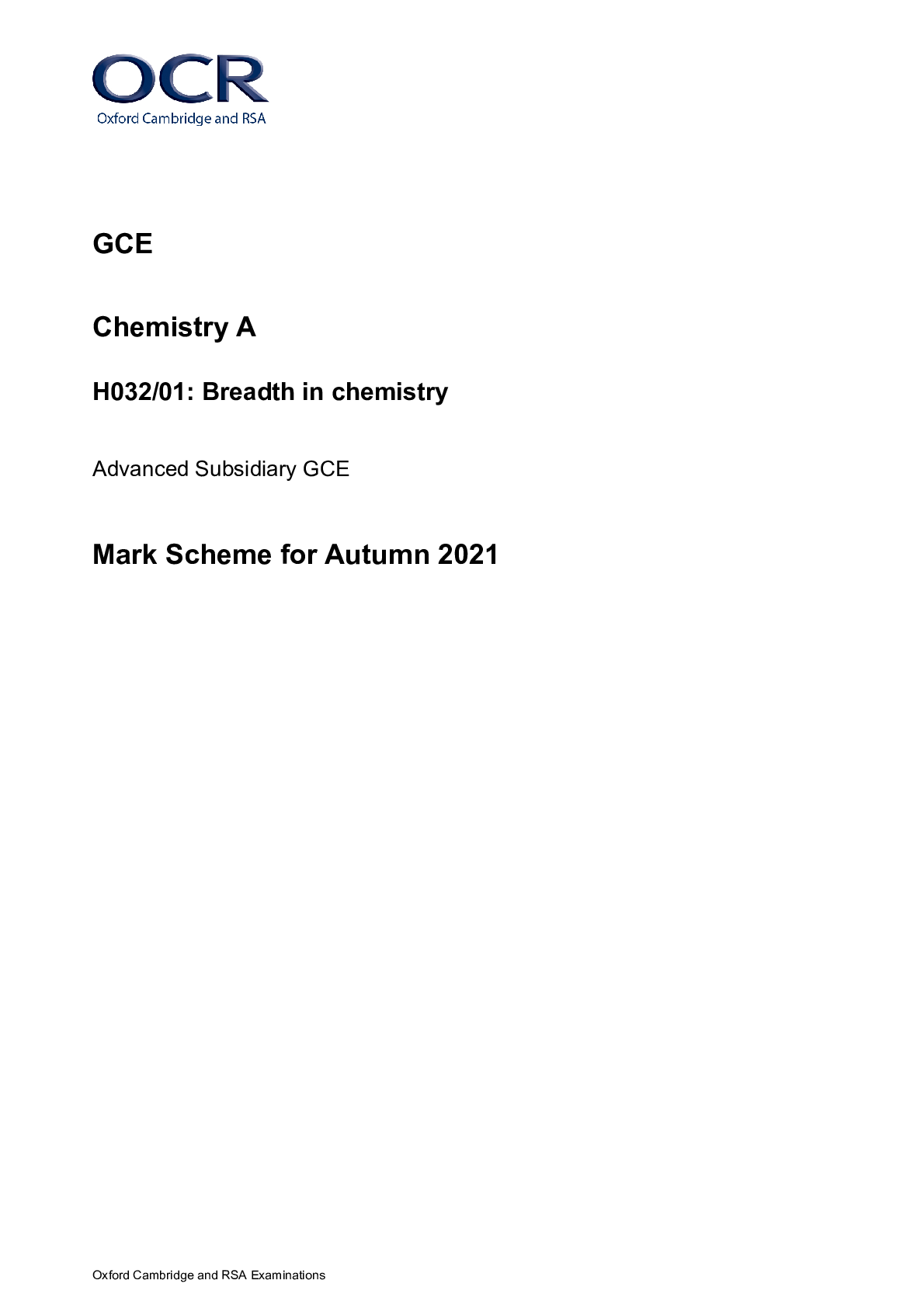
Reviews( 0 )
Document information
Connected school, study & course
About the document
Uploaded On
Oct 07, 2022
Number of pages
18
Written in
Additional information
This document has been written for:
Uploaded
Oct 07, 2022
Downloads
0
Views
47



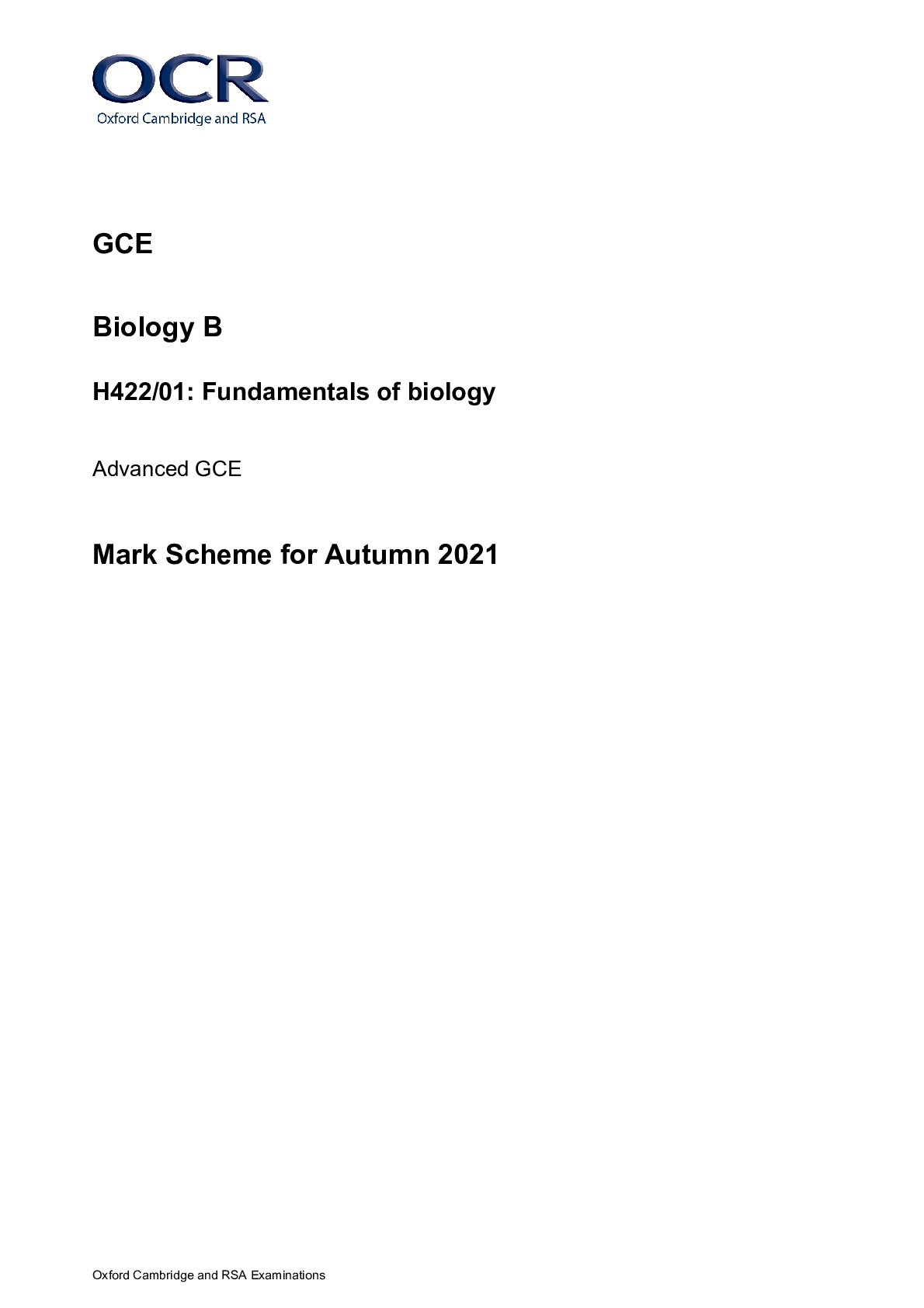
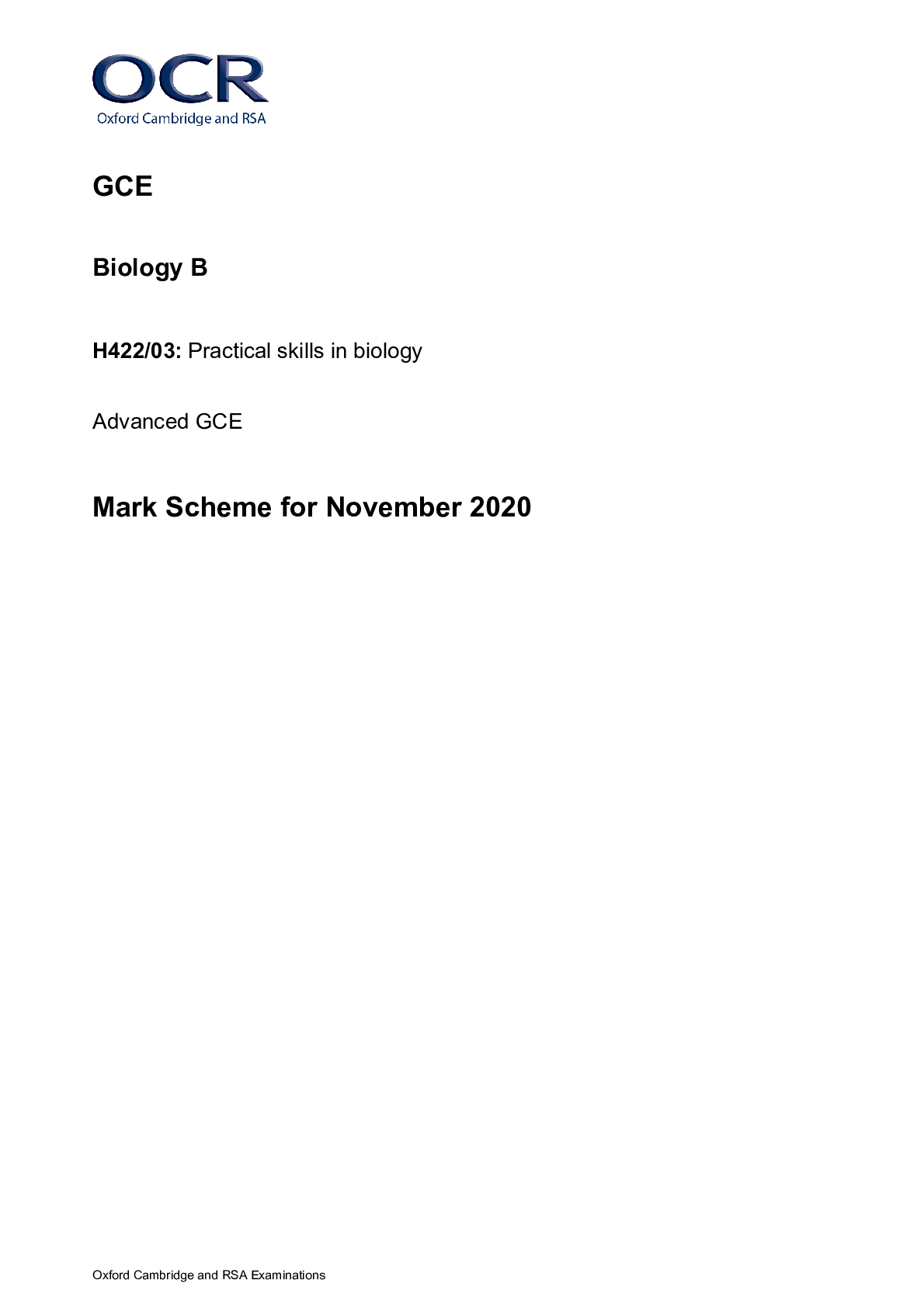
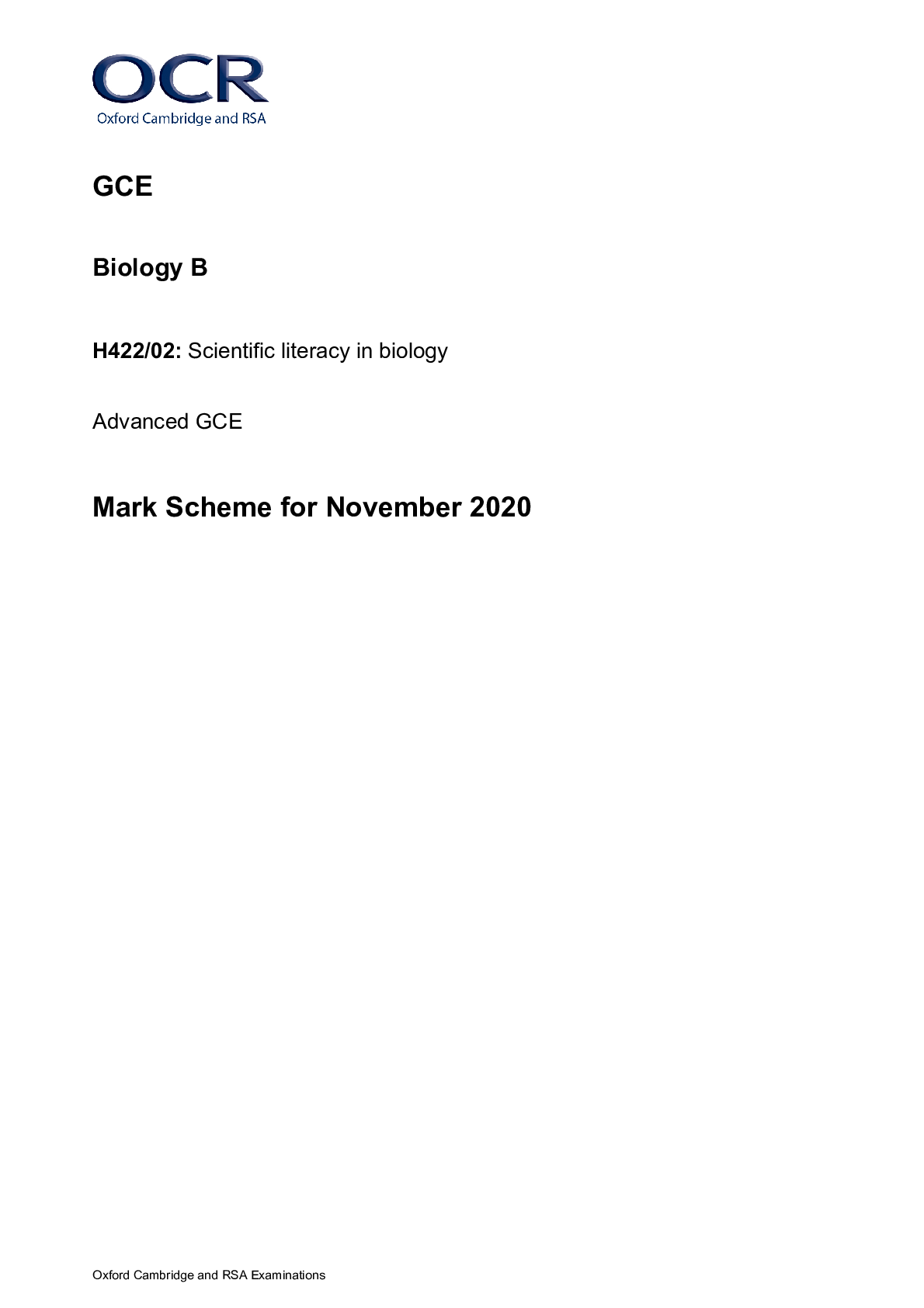
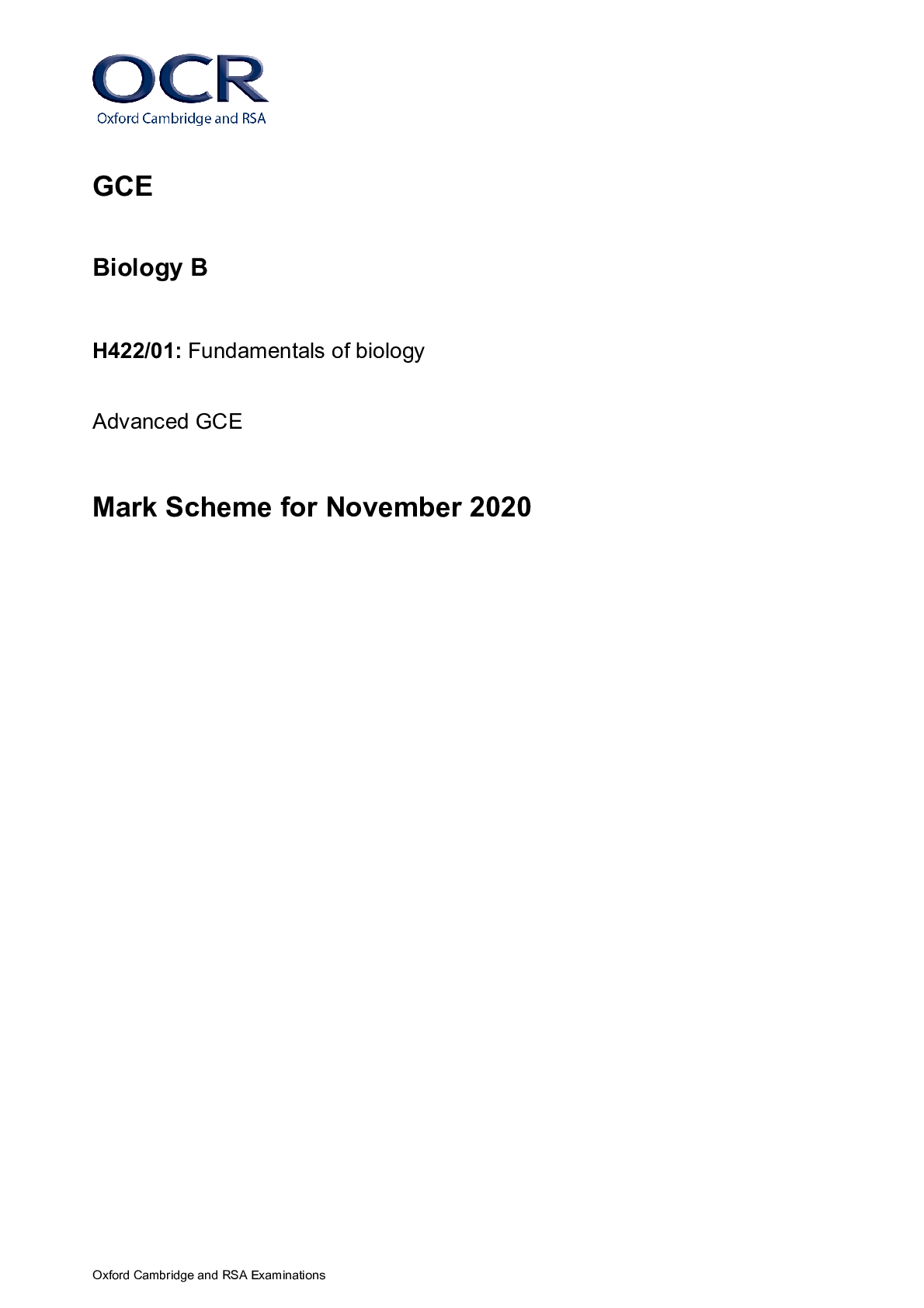

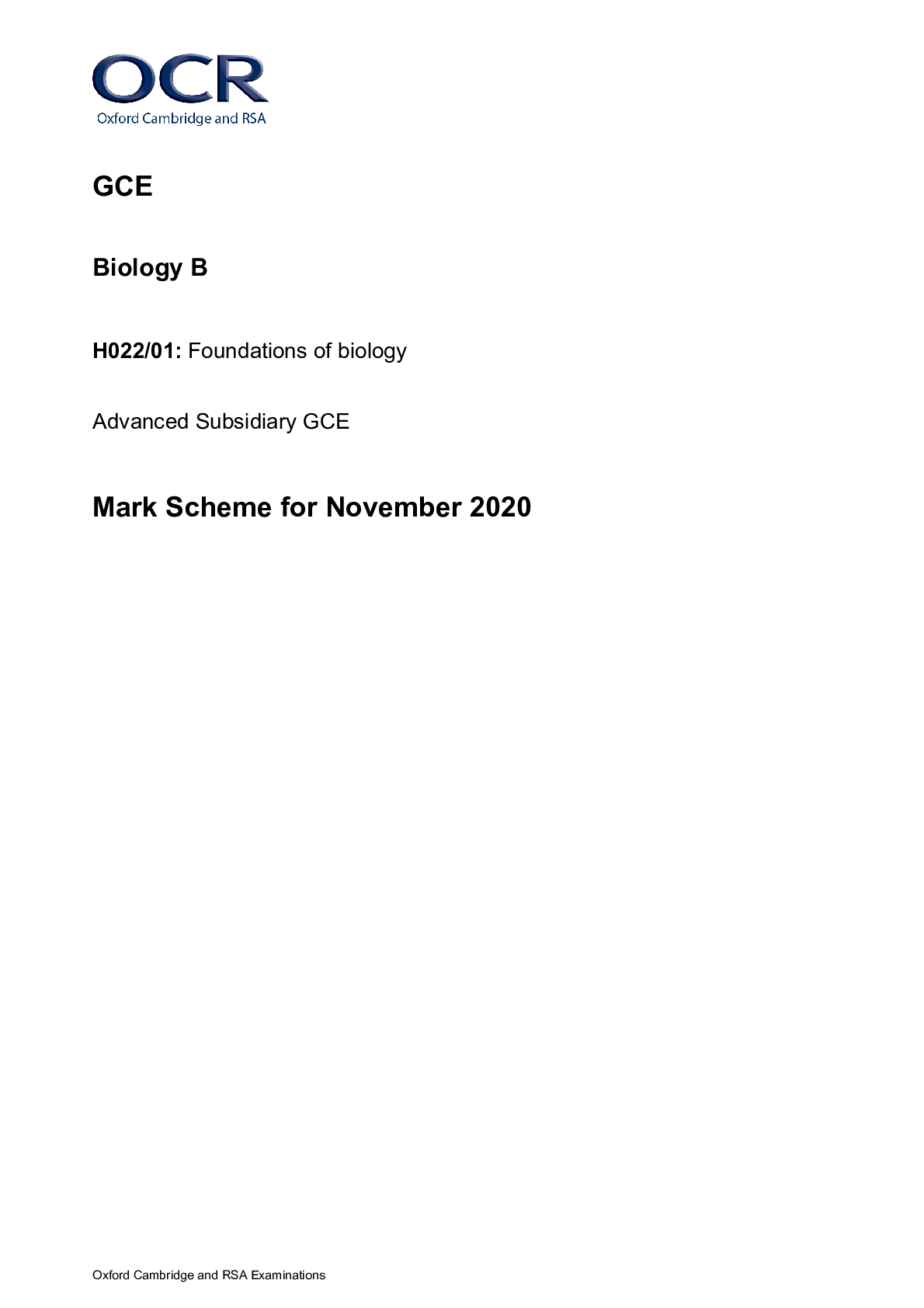
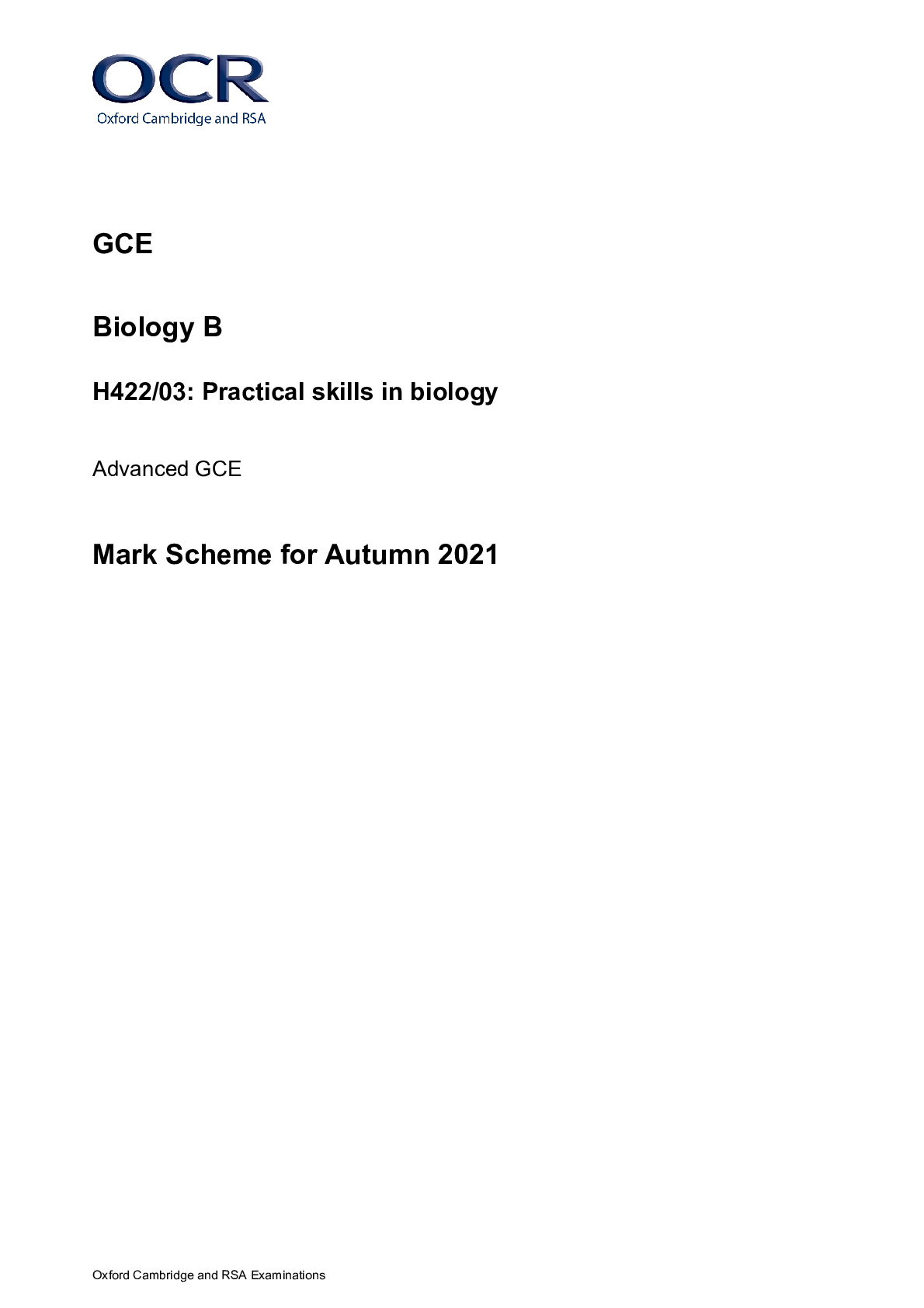
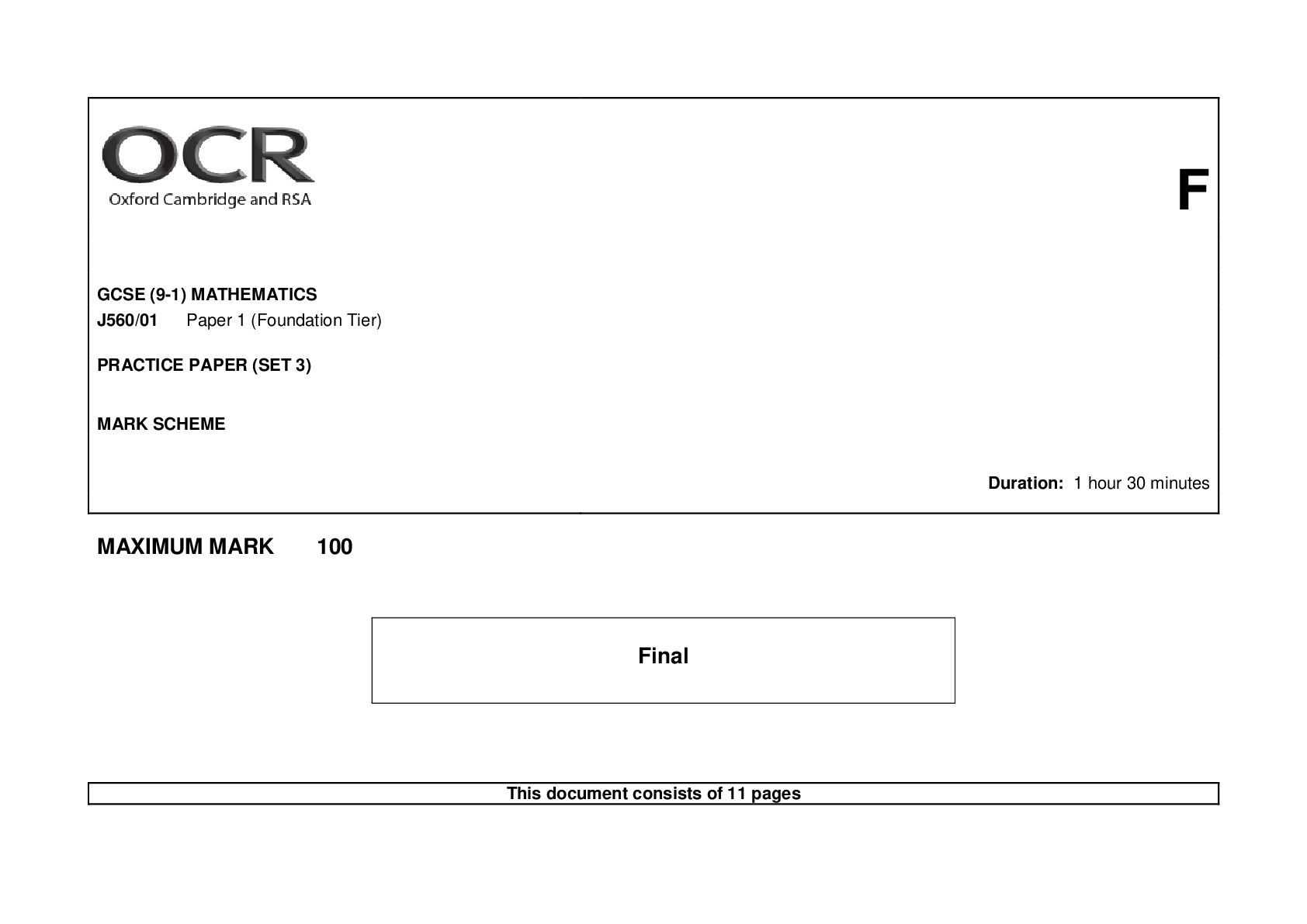
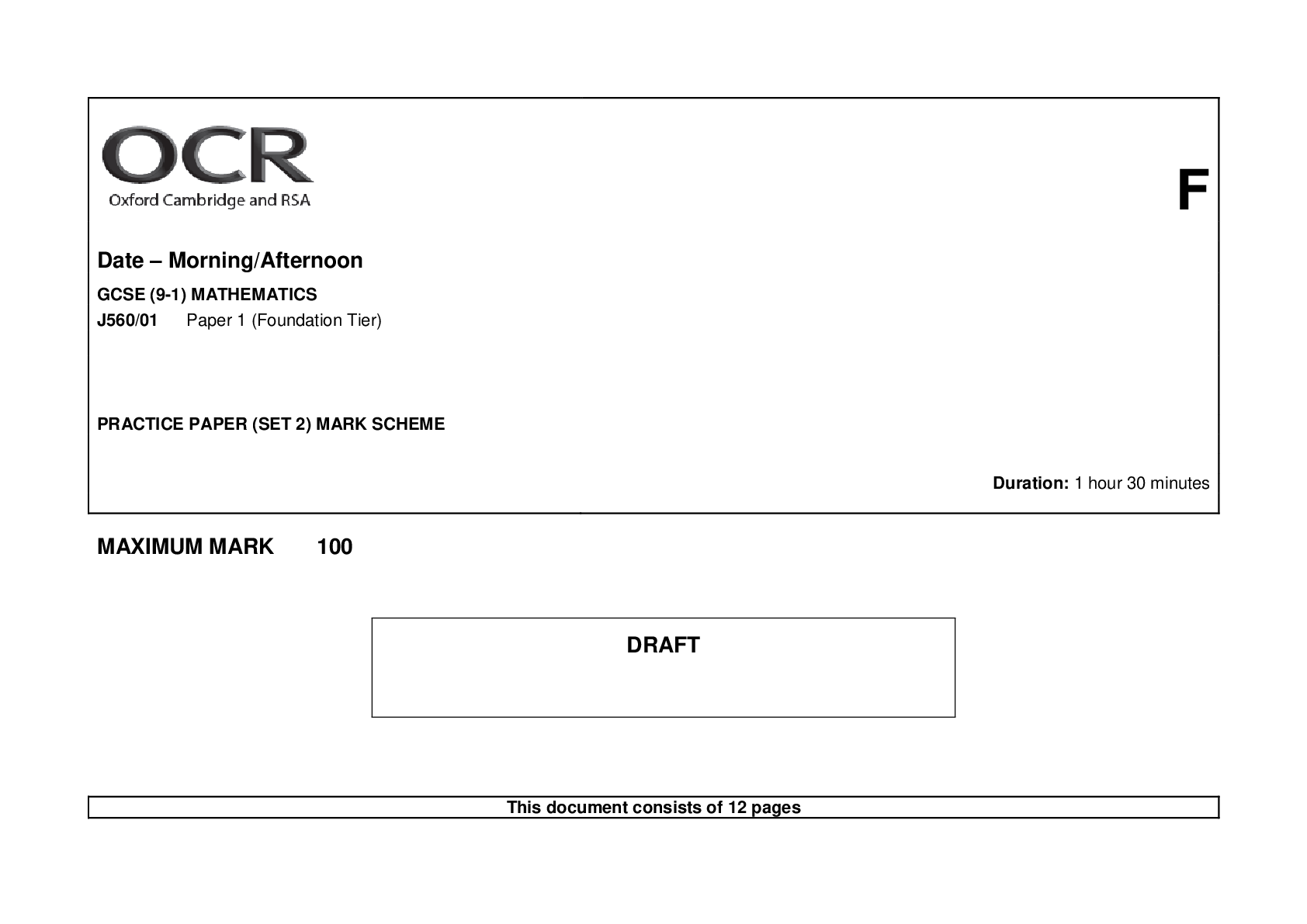
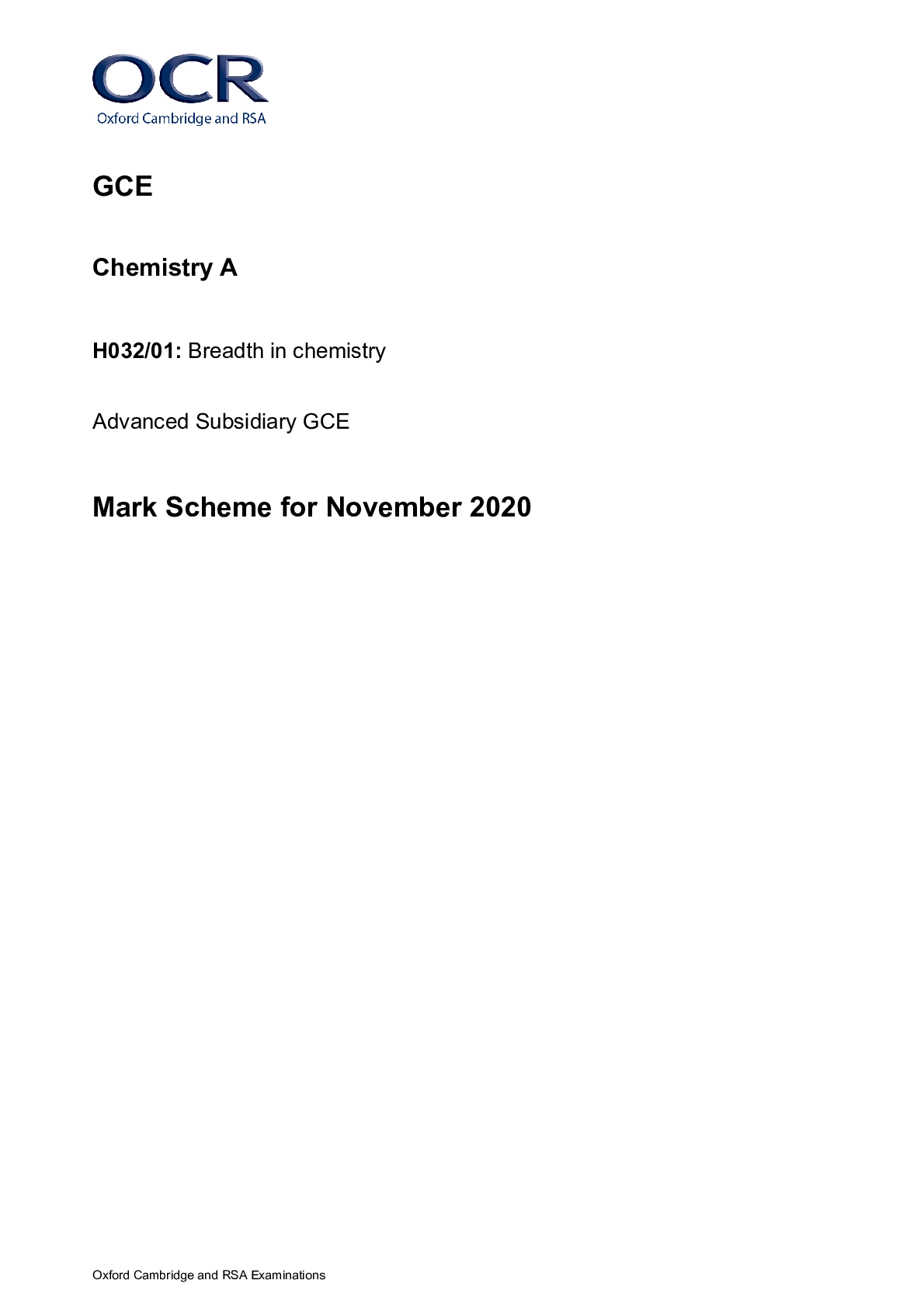

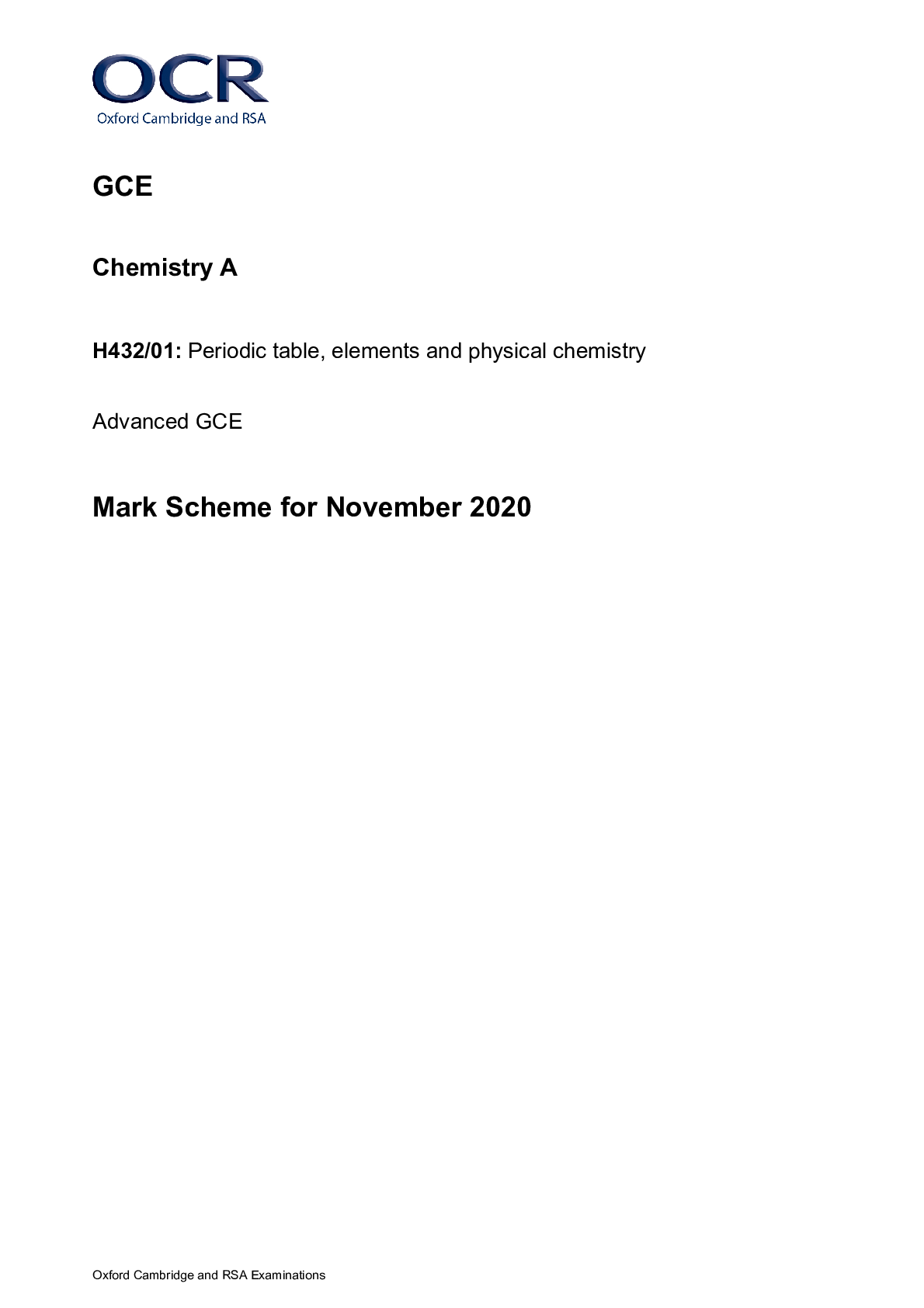
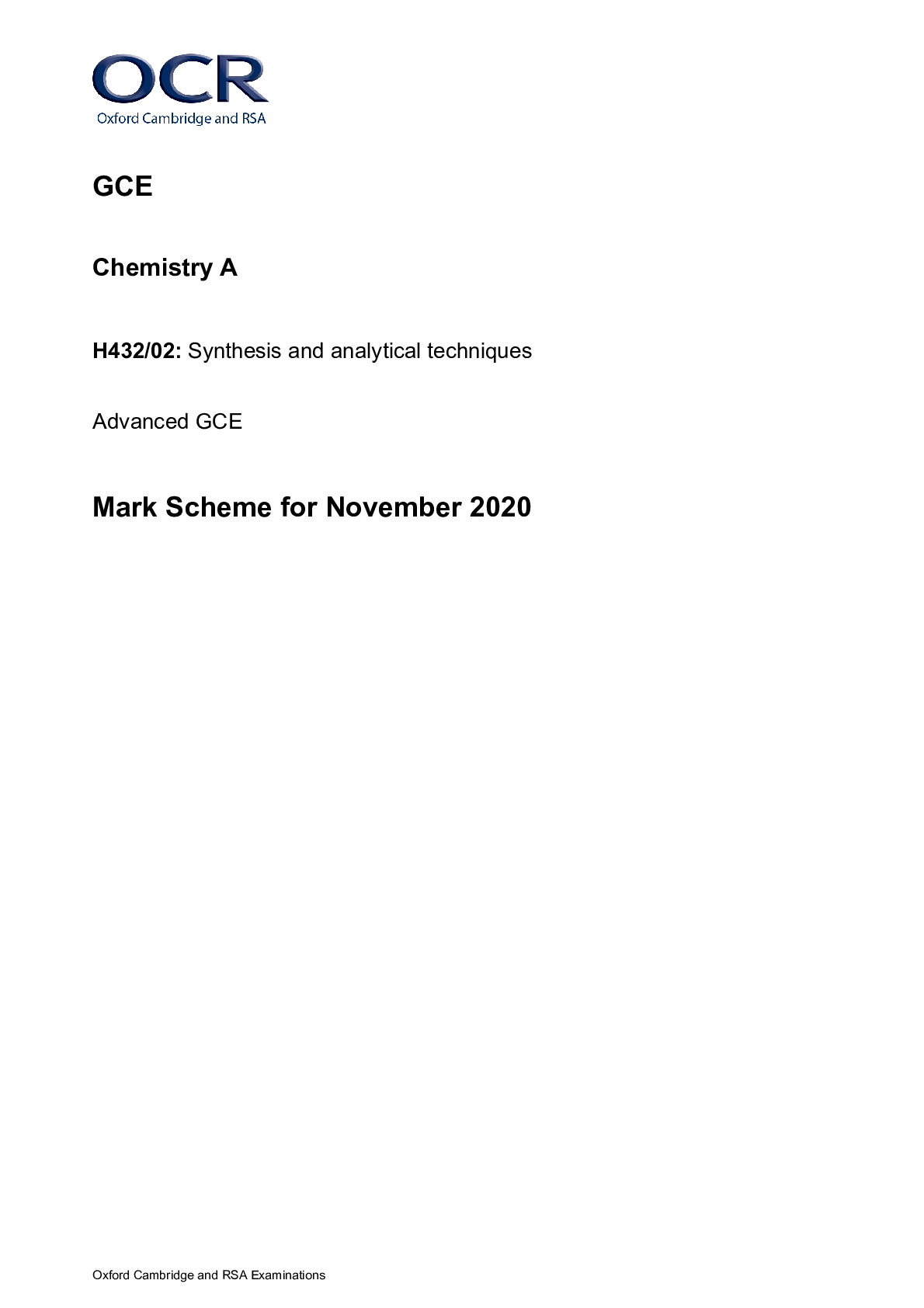

H630-02 Pure Mathematics and Statistics Advanced Subsidiary GCE Mark Scheme for Autumn 2021.png)

